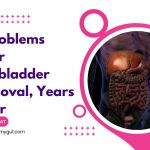Can you Still Get Gallstones after Having your Gallbladder Removed?, Gastroenterologist Explains.
Our content is not intended nor recommended as a substitute for medical advice by your doctor. Use for informational purposes only.
Can you get gallstones after having your gallbladder removed?
Gallstones can persist or come back after having your gallbladder removed. Gallstone either slips from your gallbladder to the bile duct before gallbladder removal or comes back in the bile ducts.
Gallstones don’t come back in the gallbladder, because you no longer have a gallbladder.
The presence of gallstones inside the bile duct (mainly in the common bile duct) is a known medical condition called (choledocholithiasis).
Some facts and statistics to give you an idea about this condition:
- According to the National Health and Nutrition Examination Survey (NHANES III), about 20 Mil. Americans have gallbladder disease (reference)
- Bile duct stones (choledocholithiasis) are present in 5 to 20% of patients at the time of cholecystectomy (reference1, reference2).
The missed gallstones after gallbladder removal are the most common mechanism of having gallstones after gallbladder removal.
What are the causes (mechanisms) of recurrent gallstones after cholecystectomy?
The following are the main mechanisms of having gallstones after cholecystectomy:
- Slipped gallstones from the gallbladder into the common bile duct (the most common mechanism). The stone is often missed in the common bile duct.
- Newly formed stones after gallbladder removal in the bile ducts.
- Incomplete removal of the gallbladder during laparoscopic cholecystectomy. The stone is often missed in the cystic duct (the duct connecting the gallbladder to the bile duct). Incomplete gallbladder removal is up to 13.3% of laparoscopic gallbladder removal operations (reference).
The gallstones after gallbladder removal are located in (reference):
- The common bile duct (the most common site).
- The cystic duct (due to incomplete gallbladder removal.
- Newly formed gallstones can also be found in the right and the left hepatic ducts.
- Rarely, Gallstones can form in the small bile ducts inside the liver.

Who are at higher risk of developing new bile duct gallstones after gallbladder removal?
According to studies, some patients have a higher risk of forming new gallstone inside the bile ducts (reference):
- Older ages.
- Being a female.
- High serum lipid levels (cholesterol).
- Persistent or recurrent infections of the bile ducts.
- Pregnancy.
What are the symptoms of gallstones after gallbladder removal?
The presence of gallstones typically presents with 3 main symptoms:
- Typical gallbladder pain (biliary colics).
- Symptoms of obstruction of the bile ducts.
- Symptoms of the complications (Discussed in the next section).
1. Typical gallbladder pain after cholecystectomy.
missed or newly formed stones in the bile ducts typical present with gallbladder pain (typical biliary colics).
Persistence of the biliary colic after having your gallbladder removed is an indication to see your doctor.
The symptoms of typical biliary colic are summarized below:
Biliary colic. | Description |
1. Site | Usually, The right upper quadrant of your abdomen |
2. Spread | – The pain may spread to the back of the right shoulder. – Also, it spreads to the epigastric area. |
3. Character | Constant builds up then disappears gradually. |
4. Duration | At least 30 minutes. It may last up to 6 hours. |
5. Relation to food | – Triggered by foods (especially fatty food and large meals. – However, it can start spontaneously. |
6. NOT related to: | Movement, bowel movements, nor the passage of flatus. |
7. Nausea | Often Present, severe. |
8- Commonly associated symptoms |
|
2. Symptoms of bile duct obstruction:
The presence of a gallstone in the common bile duct often results in its obstruction. The obstruction of bile outflow from the liver leads to (reference):
- Dark-colored urine (very dark yellow or brown urine).
- Clay stool (pale or greyish stool).
- Yellowish discoloration of your eye whites and skin (jaundice).
- Severe constant gallbladder pain.
- Sometimes, it is associated with fever, vomiting, nausea, and anorexia (loss of appetite).
3. Symtpoms of the other complications
See the next section.
What are the complications of such a condition?
In addition to biliary obstruction, the two most common complications of a persistent or recurrent gallstone after gallbladder removal are (reference):
1 . Infection (cholangitis).
The obstruction of the bile ducts with a stone predisposes to infection. The infection of the bile ducts is called (cholangitis).
Symptoms:
- Typical biliary colics, as we explained above.
- Fever.
- Jaundice.
- Itching.
- Elevated liver enzymes (bilirubin, ALT, AST, and Alkaline phosphatase).
2. Obstruction of the pancreatic duct (gallstone pancreatitis).
Bile duct stones can slip into the pancreatic duct and obstruct it (with or without biliary obstruction).
Obstruction of the bile duct results in acute pancreatitis:
- Acute onset, severe, persistent pain in the upper middle stomach (above the belly button).
- The pain may be in the right upper part of your stomach.
- Nausea and vomiting are present in about 90% of the causes (reference).
- The pain radiates to the back (upper mid-back area) in 50% of the cases (reference).
- Shortness of breath.
- Fever.
How can bile duct stones be detected?
Bile duct stone can be missed by traditional ultrasonography. Your doctor will detect the missed or newly formed stones after cholecystectomy based on a combination of:
- Typical symptoms (right upper abdominal pain, jaundice, etc.).
- Laboratory testing: Elevated Alkaline phosphatase, ALT, AST, and bilirubin.
- Transabdominal Ultrasound: Ultrasound can detect around 73% of the bile duct stones, according to this Meta-analysis. Sometimes, the ultrasonography reveals dilation of the CBD (common bile duct) without seeing the stone. In such a case, further investigations are required to confirm the presence of gallstones inside the CBD.
If there is a query or difficult diagnosis, your doctor may order advanced imagining or endoscopic techniques such as:
- MRCP (magnetic resonance cholangiopancreatography).
- EUS (endoscopic ultrasound).
- ECRP (endoscopic retrograde cholangiopancreatography).
What are the conditions that mimic bile duct stones?
Having symptoms that are similar to gallstones doesn’t always mean that gallstones came back. Several conditions can mimic choledocholithiasis (reference):
- Bile duct cancer
- Klatskin tumor
- Bile duct stricture (narrowing)
- Choledochal cyst.
- Peptic ulcer disease
- Acute cholecystitisSphincter of Oddi dysfunction (the sphincter at the opening of the common bile duct into the duodenum).
- Functional gallbladder disease.
- Evidence-based
- Written by a doctor.







